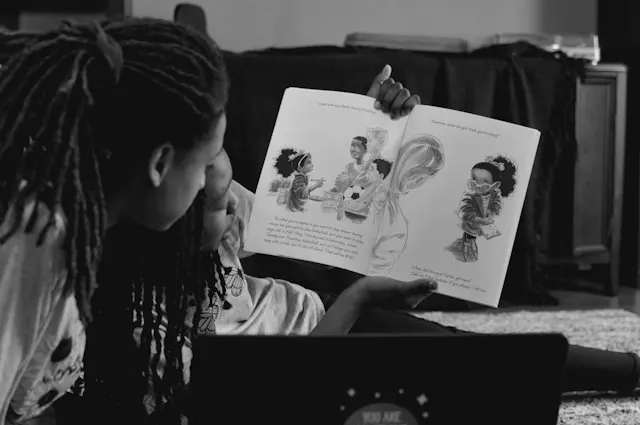Highlights
• Engaged readers value books for emotional benefits – including relaxation, escapism, and excitement
• Main barriers for reluctant readers – time constraints, lost childhood reading habits, digital distractions, and commitment concerns
• Reading motivation is highly individual – what works for one teen may not work for another, requiring personalized approaches
» 6 mins read
Reading can be a gateway to imagination, empathy, and intellectual growth—yet for many teenagers, that gateway feels firmly shut. While much has been said about how to motivate reluctant adolescent readers, the deeper question remains: Why do some teens avoid reading in the first place?
If you’ve ever wondered why some young people eagerly dive into books while others push them away, you’re not alone. The answer isn’t simple—but it’s vital. Understanding what drives reading resistance is the first step toward unlocking strategies that can help teens rediscover the joy of books.
Scientific research has shown that reading—particularly fiction—can do far more than build vocabulary. It enhances brain activity, strengthens social cognition, fosters empathy (even queer empathy), and sparks curiosity and creativity, especially through genres like science fiction. These benefits don’t always depend on whether teens are reading on paper or screens. Still, many opt out of the experience entirely.
So what’s holding them back? And more importantly—how can we help them return?
A study by Wilkinson et al. (2020) examined the reading habits of 15- and 16-year-olds, focusing specifically on printed books rather than digital formats. The researchers interviewed 39 high school students using both professional-led interviews and a unique peer-to-peer approach, where 10 adolescents were trained to interview their classmates. This method created informal discussions that revealed authentic perspectives on why teens choose to read or become reluctant readers.

Why Some Teens Embrace Reading
Before addressing the needs of reluctant readers, it’s essential to first understand what draws teens toward books in the first place. Research has identified several key motivators that drive adolescent engagement with reading.
For many teens, books provide emotional benefits—serving as a refuge from daily stresses and a way to relax and unwind. In a world filled with constant stimulation, reading offers a rare opportunity for mental peace and personal space.
Beyond emotional relief, books also contribute to personal growth. They expose readers to different lives, ideas, and perspectives, allowing teens to develop empathy and expand their understanding of the world. These narratives can foster a sense of self-awareness and intellectual curiosity, encouraging teens to think critically and compassionately.
Reading also plays a social role. For some teens, books are a source of connection—providing shared experiences that can lead to friendships and meaningful conversations. Whether through formal book clubs or informal chats with peers, reading becomes a gateway to bonding over common interests.
And of course, many teens read simply because they enjoy it. For them, books are entertaining and engaging, offering an immersive form of storytelling that rivals other forms of media. Rather than viewing reading as a chore, they see it as a source of excitement and pleasure.
Common Barriers That Create Reluctant Readers
Understanding why some teens enjoy reading is only half the picture. To support reluctant readers, we must first explore the barriers that stand in their way.
One of the most common challenges is time. Adolescents today lead incredibly busy lives, balancing schoolwork, extracurriculars, jobs, and social commitments. Even those who enjoy reading may struggle to carve out space for it. When every hour is accounted for, reading starts to feel like a luxury—one that often gets pushed aside.
Another barrier is the gradual loss of reading habits. Many reluctant readers were once avid readers in childhood but have drifted away from the habit over time. As academic pressure builds and social priorities shift, reading can start to feel less rewarding, especially when it’s associated more with schoolwork than personal enjoyment. Without consistent encouragement from home or school, these early habits can fade.
Digital distractions also play a significant role. The constant availability of smartphones, video games, social media, and streaming services creates an environment where instant gratification is the norm. These platforms are designed to be stimulating and effortless to consume, which can make the slower, more reflective nature of reading feel less appealing. This shift has reshaped attention spans and reduced the mental stamina needed for sustained reading.
For some teens, the very idea of finishing a book can feel overwhelming. Commitment concerns—whether related to time, energy, or confidence—can discourage them from even starting. In a media landscape filled with bite-sized content, reading a full-length book may seem like a major effort with an uncertain payoff. This perception, even more than lack of ability or interest, often keeps reluctant readers from engaging.

Strategies for Supporting Reluctant Readers
Helping these teens requires a thoughtful, flexible approach that addresses their specific needs and challenges.
One effective strategy is to address time management by helping teens identify small, manageable windows for reading—whether it’s during commutes, lunch breaks, or before bed. Recommending shorter books or audiobooks can also help make reading feel more accessible.
Reducing pressure is equally important. Reading shouldn’t feel like a chore or a test. Giving teens the autonomy to choose what they read—based on their personal interests rather than a prescribed list—can transform the experience from obligation to exploration.
Creating social opportunities around reading can also make a difference. Book clubs, reading partnerships, or family reading time can shift the perception of reading from a solitary task to a shared activity. For many reluctant readers, the social dimension adds motivation and accountability.
Finally, offering diverse formats can help broaden access. Some teens may find traditional novels intimidating or unappealing, but respond well to graphic novels, audiobooks, or digital texts. Providing a variety of options ensures that reading feels inclusive and adaptable, not rigid or exclusive.
By understanding both the motivations of engaged readers and the barriers faced by reluctant ones, we can begin to create environments that nurture a love for reading—one that is flexible, meaningful, and lasting.
The Individual Nature of Reading Motivation
The research emphasizes that reading motivation varies significantly among individuals. What transforms one person into an avid reader might not work for another. Reluctant readers often have valid reasons for their resistance that deserve understanding rather than judgment.
Some teens might prefer visual learning styles that make traditional text-heavy books challenging. Others might have learning differences that make reading more difficult. By recognizing these individual differences, you can better support reluctant readers in finding their path to literacy engagement.
The journey from reluctant reader to bookworm is rarely linear or quick. It requires creating positive associations with reading, addressing individual barriers, and celebrating small victories along the way. Remember that every reluctant reader has the potential to become an enthusiastic one.
Disclaimer: This post is intended for general informational purposes only. It does not offer recommendations, endorse specific practices, or serve as a basis for educational or therapeutic decisions.
This post is a summary of a peer-reviewed article published in a rigorous scientific journal. For full details, methodology, and context, please refer to the original publication cited here: Wilkinson, K., Andries, V., Howarth, D., Bonsall, J., Sabeti, S., & McGeown, S. (2020). Reading During Adolescence: Why Adolescents Choose (or Do Not Choose) Books. Journal of Adolescent & Adult Literacy, 64(2), 157-166. DOI: 10.1002/jaal.1065.